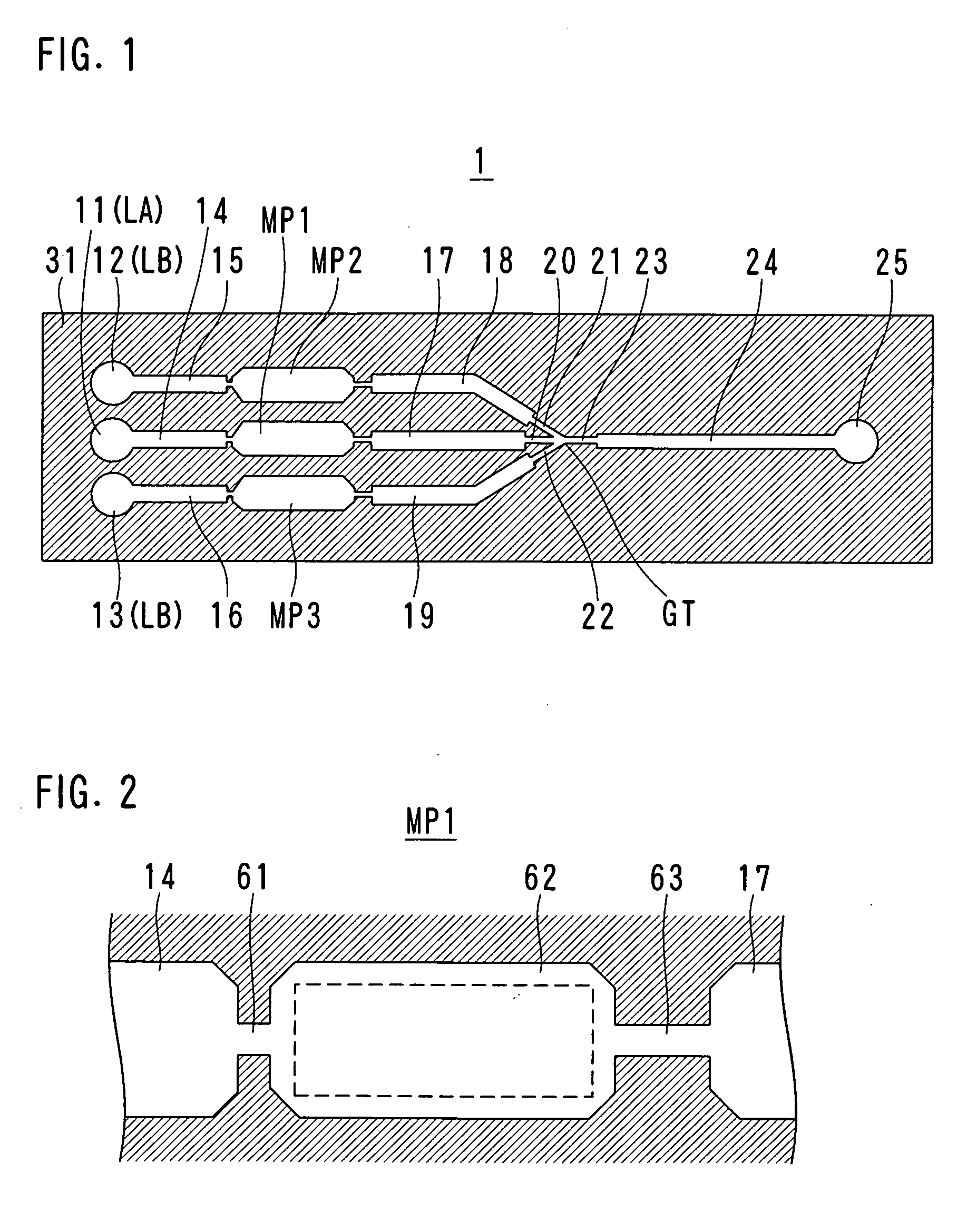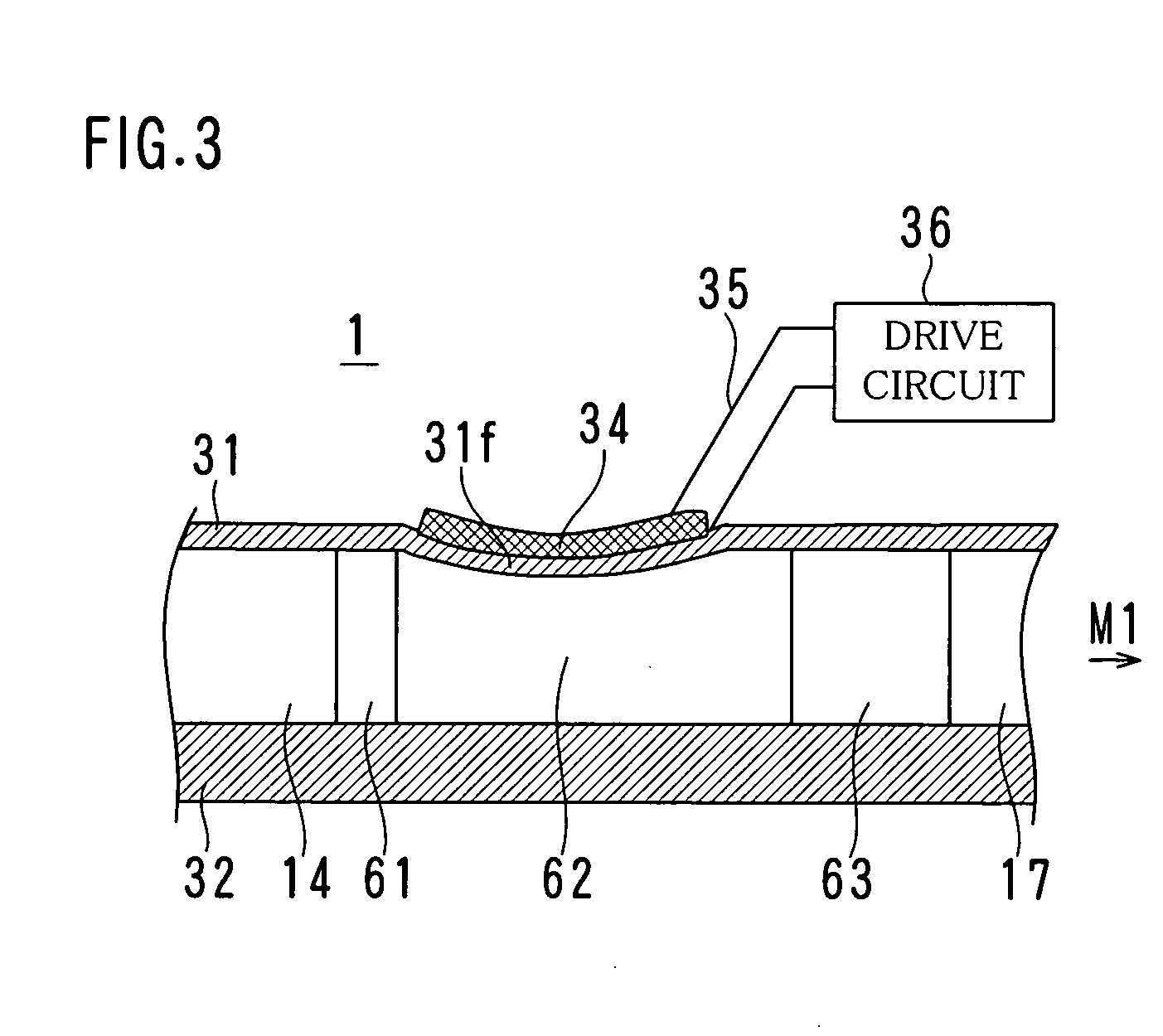Method, device and system for mixing liquids
a technology of liquid mixing and mixing device, applied in the direction of liquid displacement, separation process, instruments, etc., can solve the problems of difficult control of liquid transport, inability to meet expectations, and high time consumption, so as to minimize the uneven concentration and precise mixing ratio
- Summary
- Abstract
- Description
- Claims
- Application Information
AI Technical Summary
Benefits of technology
Problems solved by technology
Method used
Image
Examples
first embodiment
[0047]FIG. 1 is a plan view schematically showing a structure of a microfluidic system 1 that is a first embodiment of a mixing device in the present invention, FIG. 2 is a plan view of a micropump MP1 shown in FIG. 1, FIG. 3 is a front sectional view of the micropump MP1, FIGS. 4A-4H show an example of a manufacturing process of the micropump MP1, FIG. 5 is a diagram showing an example of channel resistance characteristics of openings of the micropump MP1, and FIGS. 6A and 6B as well as FIGS. 7A and 7B show examples of waveforms of a drive voltage of a piezoelectric element respectively.
[0048] Referring to FIG. 1, the microfluidic system 1 is structured on a silicon substrate 31 in the form of a microchip. The microfluidic system 1 is so structured that a liquid LA delivered by the middle micropump MP1 and a liquid LB delivered by each of micropumps MP2 and MP3 that are provided on the both sides of the micropump MP1 flow together at a confluence GT, and thereby to mix together fo...
second embodiment
[0118] In the microfluidic system 1 of the first embodiment discussed above, the micropumps MP1-MP3 are used, the number of which is equal to the number of channels 17-19 joining together at the confluence GT. Instead, in the second embodiment, one micropump MP is used to transport a liquid LB and a channel is branched, since the channels 18 and 19 joining together transport the same liquid LB.
[0119]FIG. 17 is a plan view schematically showing a structure of a microfluidic system 1B according to the second embodiment of the present invention.
[0120] As shown in FIG. 17, the microfluidic system 1B includes ports 11B and 12B, micropumps MP1 and MP2, channels 17B, 18B and 19B, narrow channels 20-23, a channel 24 and a port 25.
[0121] A liquid LA having a low mixing rate is supplied to the port 11B, while a liquid LB having a high mixing rate is supplied to the port 12B. The liquid LA is transported to the channel 17B by the micropump MP1, then to be delivered from the narrow channel 2...
third embodiment
[0140] In the embodiments discussed above, the systems are structured in which a liquid delivered from channels formed on both sides of a middle channel flow together with respect to a liquid delivered from the middle channel at the same confluence GT. It is not necessarily, however, that the liquids flow together at the same position. The liquids delivered from the both sides can interflow at separate positions. In addition, it is not required that the interflow is provided symmetrically.
[0141] In this third embodiment, a description is provided of a microfluidic system 1E in which a liquid LB delivered from both sides interflow at respective different positions.
[0142]FIG. 20 is a plan view schematically showing a structure of the microfluidic system 1E according to the third embodiment of the present invention, and FIG. 21 is a plan view schematically showing a structure of a microfluidic system 1F that is a modified example of the third embodiment.
[0143] Referring to FIG. 20, ...
PUM
| Property | Measurement | Unit |
|---|---|---|
| Reynolds number | aaaaa | aaaaa |
| width | aaaaa | aaaaa |
| thickness | aaaaa | aaaaa |
Abstract
Description
Claims
Application Information
 Login to View More
Login to View More - R&D
- Intellectual Property
- Life Sciences
- Materials
- Tech Scout
- Unparalleled Data Quality
- Higher Quality Content
- 60% Fewer Hallucinations
Browse by: Latest US Patents, China's latest patents, Technical Efficacy Thesaurus, Application Domain, Technology Topic, Popular Technical Reports.
© 2025 PatSnap. All rights reserved.Legal|Privacy policy|Modern Slavery Act Transparency Statement|Sitemap|About US| Contact US: help@patsnap.com



